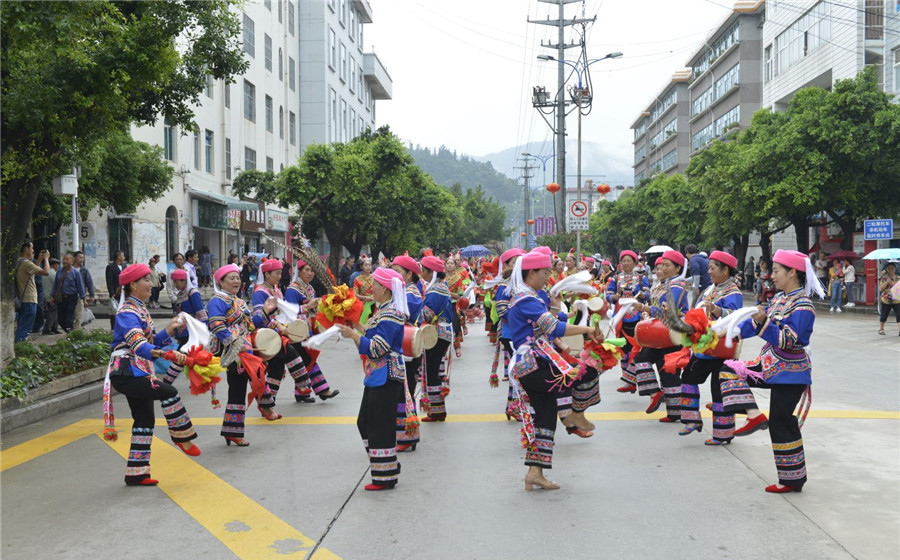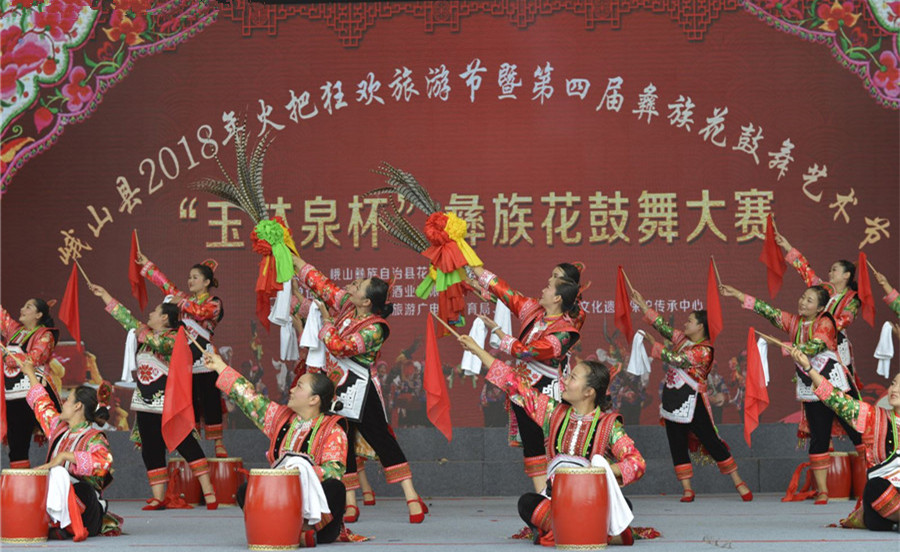Historical Origins and Artistic Features
Origins and Functional Evolution
Originally performed during funeral ceremonies, the dance aimed to “send the soul back to the ancestors,” expressing mourning and blessings for the deceased (送灵归祖).
It has since evolved into a festive performance, commonly seen during traditional Yi events such as the Torch Festival (火把节), Migaha (咪嘎哈), and the Kai Xin Jie (开新街) celebrations.
Performance Structure
The dance consists of two parts: Ji Gu (急鼓, fast drum) and Ban Gu (板鼓, slow drum):
-
Ji Gu: Fast-paced and vigorous, showcasing the bold and unrestrained style of Yi dance.
-
Ban Gu: More solemn and gentle, emphasizing ritualistic expression.
Performances are accompanied by props such as the “green pheasant tail” dragon head (箐鸡尾龙头), flower drums (花鼓), mallets (槌), white handkerchiefs, large cymbals (大钹), small cymbals (小钹), and small gongs (小铓).
Dance Techniques
The choreography centers on footwork, involving techniques like stomping, stepping, kicking, pounding, squatting, circling, and bouncing—combining strength with agility.
There are 35 traditional routines, including “Worship the Four Directions” (拜四方), “Snail Spin” (螺蛳转), “Ghost Foot Dance” (鬼跳脚), and “Buckwheat Cutting Tune” (割荞调).

 7 Days GolfingTour
7 Days GolfingTour
 8 Days Group Tour
8 Days Group Tour
 8 Days Yunnan Tour
8 Days Yunnan Tour
 7 Days Shangri La Hiking
7 Days Shangri La Hiking
 11 Days Yunnan Tour
11 Days Yunnan Tour
 6 Days Yuanyang Terraces
6 Days Yuanyang Terraces
 11 Days Yunnan Tour
11 Days Yunnan Tour
 8 Days South Yunnan
8 Days South Yunnan
 7 Days Tea Tour
7 Days Tea Tour
 8 Days Muslim Tour
8 Days Muslim Tour
 12 Days Self-Driving
12 Days Self-Driving
 4 Days Haba Climbing
4 Days Haba Climbing
 Tiger Leaping Gorge
Tiger Leaping Gorge
 Stone Forest
Stone Forest
 Yunnan-Tibet
Yunnan-Tibet
 Hani Rice Terraces
Hani Rice Terraces
 Kunming
Kunming
 Lijiang
Lijiang
 Shangri-la
Shangri-la
 Dali
Dali
 XishuangBanna
XishuangBanna
 Honghe
Honghe
 Kunming
Kunming
 Lijiang
Lijiang
 Shangri-la
Shangri-la
 Yuanyang Rice Terraces
Yuanyang Rice Terraces
 Nujiang
Nujiang
 XishuangBanna
XishuangBanna
 Spring City Golf
Spring City Golf
 Snow Mountain Golf
Snow Mountain Golf
 Stone Mountain Golf
Stone Mountain Golf














 What Our Customers Say?
What Our Customers Say? alt="Puer Surrounding Counties and Towns: Weekly & Special Local Markets Travel Guide"
/>
alt="Puer Surrounding Counties and Towns: Weekly & Special Local Markets Travel Guide"
/>

